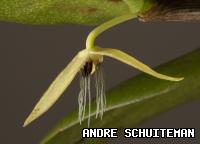World's First Night Flowering Orchid Discovered
 Bulbophyllum nocturnum
Bulbophyllum nocturnumBotanists from the Royal Botanic Gardens, Kew and the Netherlands Centre for Biodiversity Naturalis have described the first night-flowering orchid known to science.
The new night flowering species, Bulbophyllum nocturnum, from the island of New Britain near Papua New Guinea, is the first known example of an orchid species with flowers that consistently open after dark and close in the morning. Its flowers last one night only.
For images of the Bulbophyllum nocturnum please click here.
A relatively small number of plant species have flowers that open at night and close during the day. Until now, no orchids were known among them. This in spite of the fact that many orchids are pollinated by moths. But these moth-pollinated orchids all have flowers that remain open during the day, even if they are mainly pollinated after dark. Examples of plant species with flowers that open after dark and close before or shortly after sunrise include the queen of the night cactus (Selenicereus grandiflorus), the midnight horror tree (Oroxylum indicum) and the night blooming jasmine (Cestrum nocturnum).
Bulbophyllum nocturnum was discovered by Dutch orchid specialist Ed de Vogel on a field trip to the island of New Britain, where he was allowed to collect some orchids in a logging area for cultivation at the Hortus Botanicus in Leiden, the Netherlands.
Under the care of garden manager Art Vogel one of these plants soon produced buds. Their opening was eagerly anticipated as de Vogel and his colleagues had already established that this plant was a member of the Epicrianthes group of orchids of the genus Bulbophyllum. Epicrianthes contains many rare and bizarre species, most of which have only been discovered recently as they occur in some of the remotest jungle habitats on earth.
Bulbophyllum nocturnum belongs to a group of species, Epicrianthes, within the genus Bulbophyllum, that are noteworthy for their bizarre flowers with strange appendages, which often resemble leggy insects, small hairy spiders or intricate sea-creatures. These appendages are often attached by extremely thin filaments, which cause them to move erratically in the slightest breeze. The wriggling flowers look more like small creatures than like parts of a plant.
Frustratingly, however, the buds all withered once they had seemingly reached the size at which they should open. Wanting to get to the bottom of this, de Vogel took the plant home with him one evening in order to find out exactly what happened to the buds.
To his surprise, the bud that was then present opened up at ten in the evening, long after dark, revealing the flower of an undescribed species.
Observations on subsequent buds confirmed that they all opened around 10pm, and closed the next morning around 10am (This was observed in cultivation in the Netherlands in winter, which implies that the flowers closed a few hours after sunrise.). The flowers lasted only one night, which explained why the buds were seemingly about to open one day and withered the next.
Royal Botanic Gardens, Kew orchid specialist, André Schuiteman, and Leiden Bulbophyllum expert, Jaap Vermeulen, teamed up with de Vogel to investigate and describe this remarkable new species.
Says André Schuiteman of the discovery, “This is another reminder that surprising discoveries can still be made. But it is a race against time to find species like this that only occur in primeval tropical forests. As we all know, such forests are disappearing fast. It is therefore increasingly important to obtain funding for the fieldwork required to make such discoveries.”
Why Bulbophyllum nocturnum has adopted a night flowering habit is unknown and requires further investigation. However, it may be speculated that its pollinators are midges that forage at night.
Orchids with insect-like flowers are often pollinated by pseudo-copulation, as they usually mimic female insects to attract males (the orchid genus Ophrys is a well-known example). However, this is probably not the case for Epicrianthes species, nor is it likely that the flowers mimic prey animals to lure carnivorous insects. The midges observed to visit some Epicrianthes species did not display behaviour consistent with pseudo-copulation, while they were evidently too small to act as ‘attackers’. The authors point out the striking resemblance between the appendages of the flowers and the fruiting bodies of certain slime moulds (Myxomycota). It may be speculated that the pollinators are midges that normally feed on slime moulds or small fungi.
Kew’s Tropical Extravaganza festival runs from 4 February – 4 March 2012 and will celebrate the beauty and diversity of orchids. Orchids make up what is probably the largest plant family on earth, with an estimated 25,000 species. Their flowers show a tremendous range of variation in size, colour and shape.
For more information about the Tropical Extravaganza click here.
Article posted on 23 Nov 2011.
